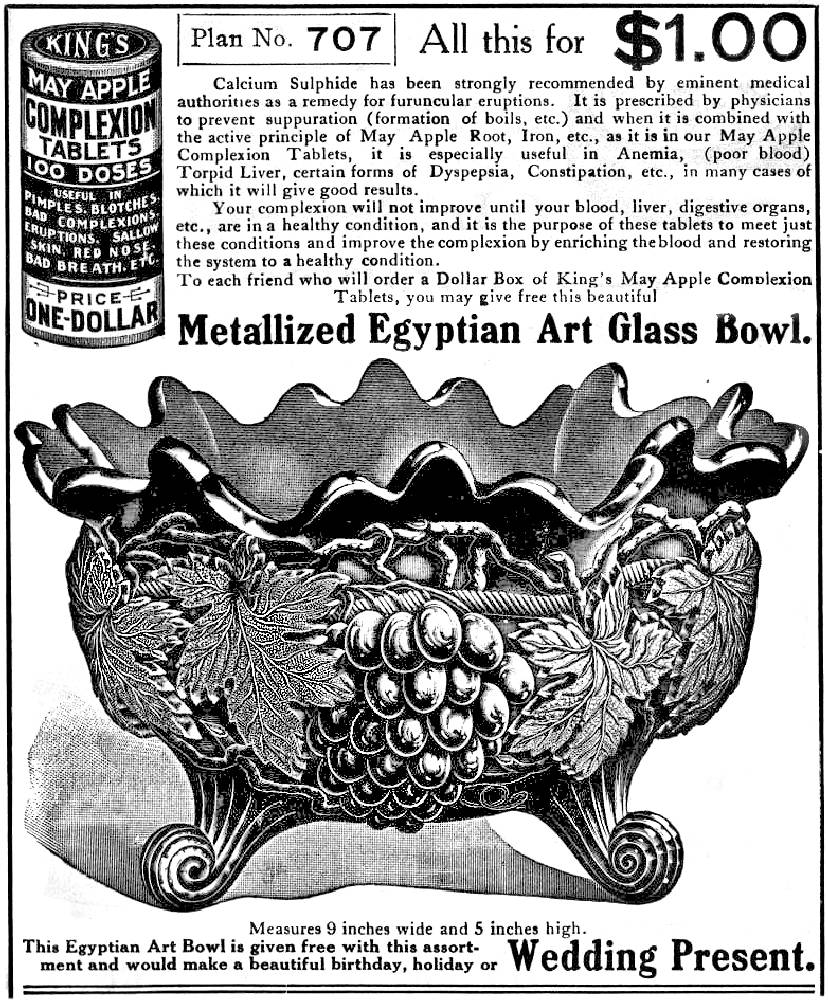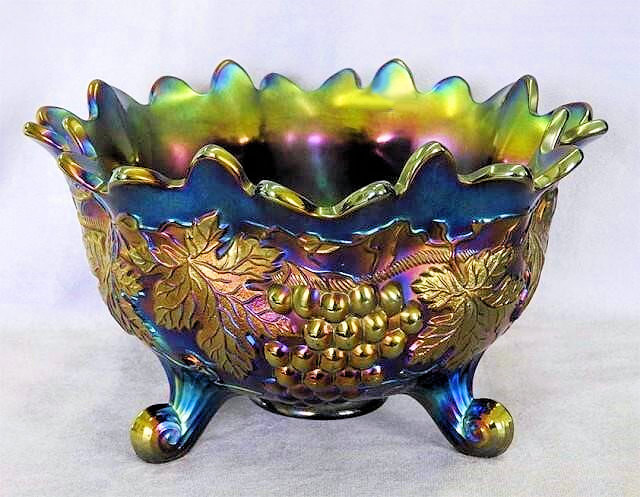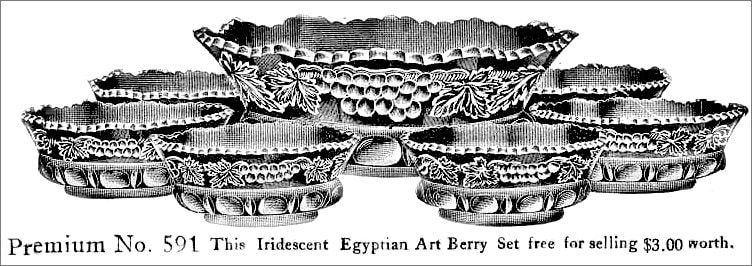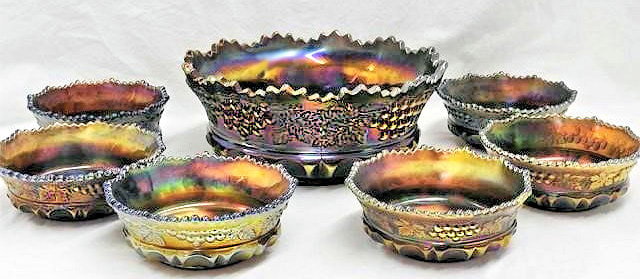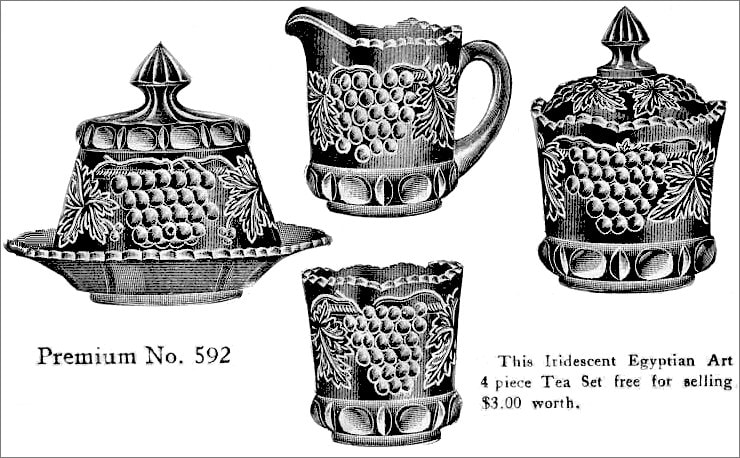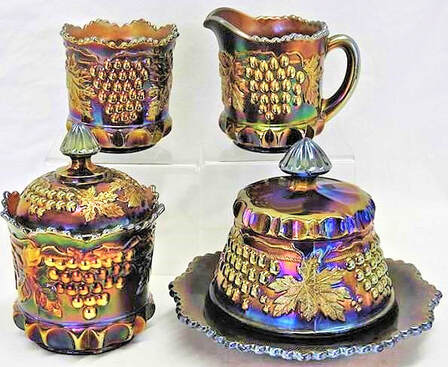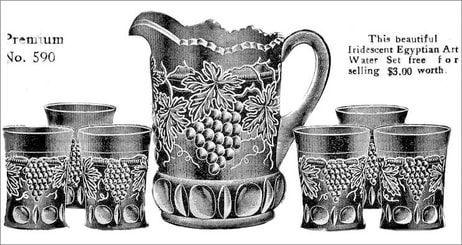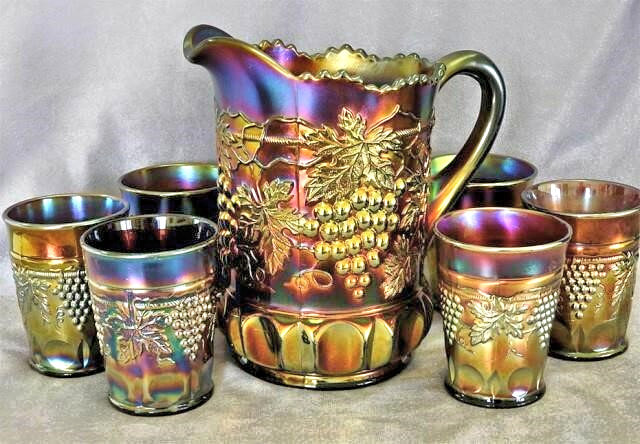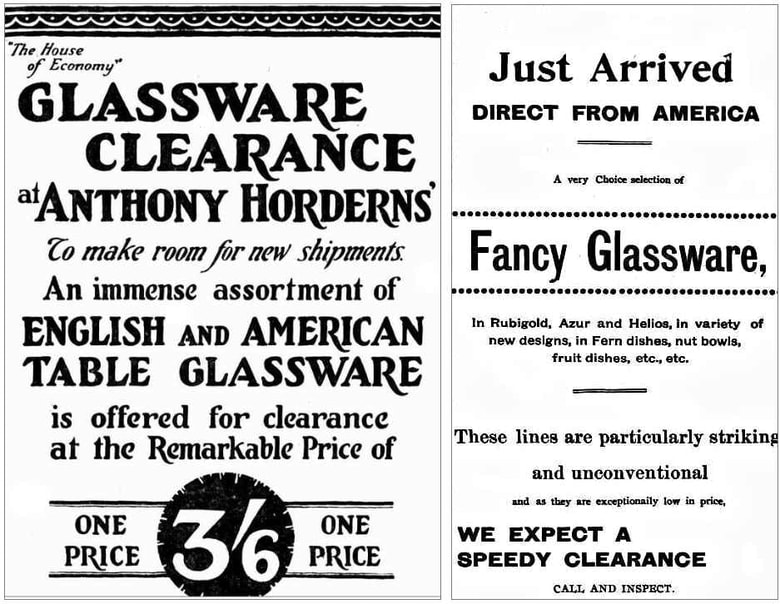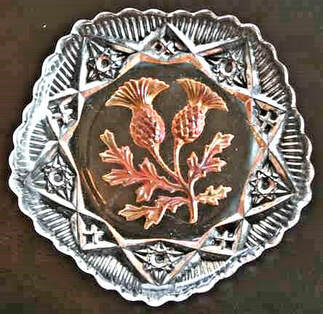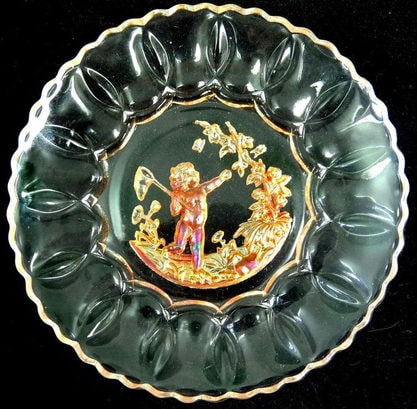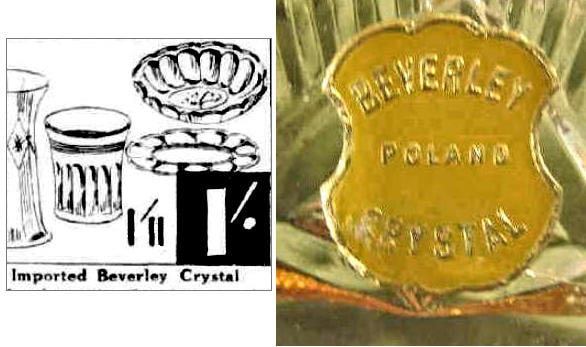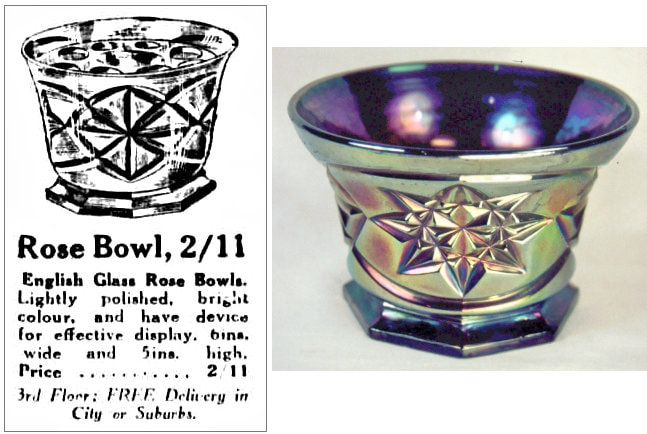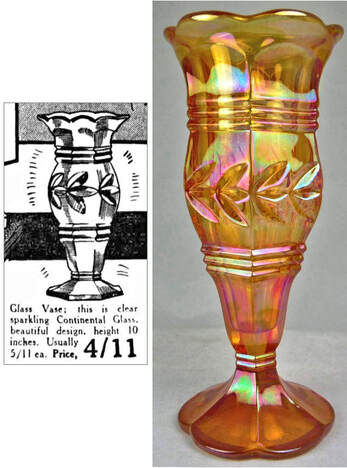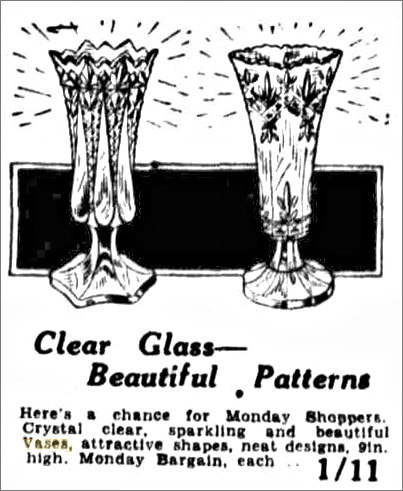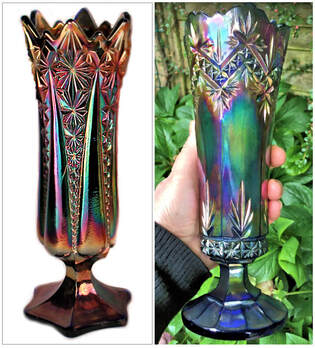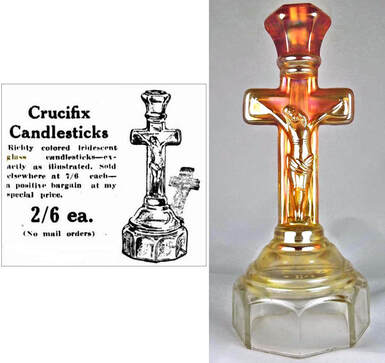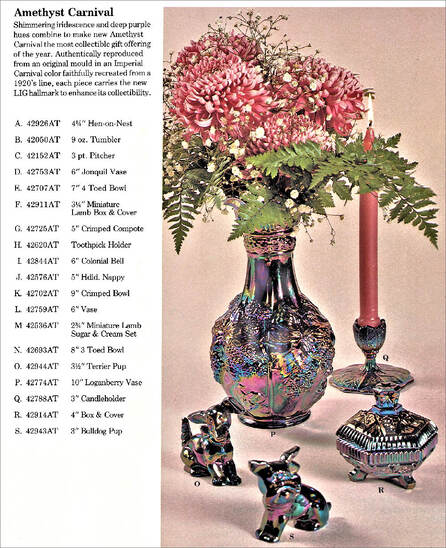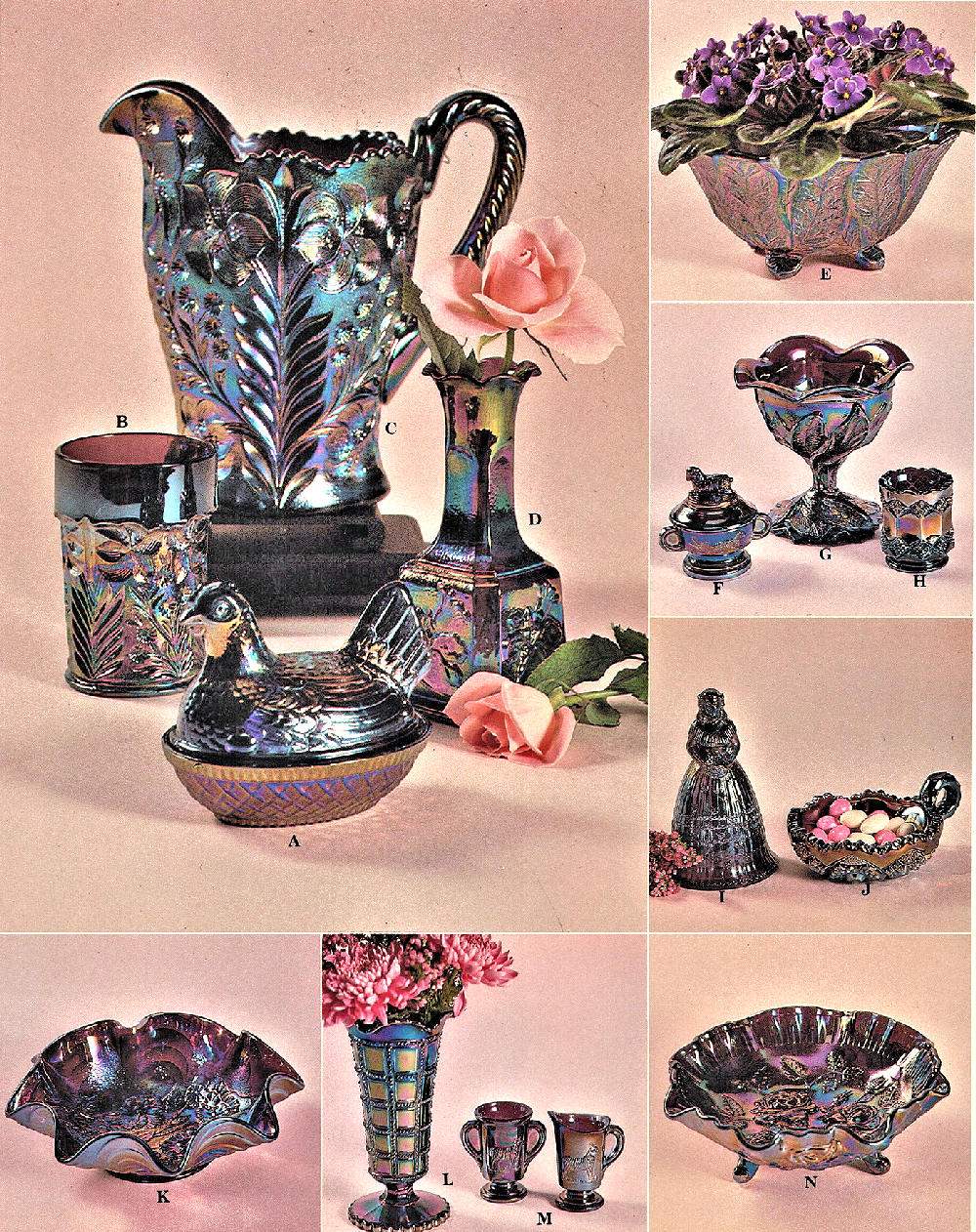NetworK ezine Issue 99. August 2023
Totally Devoted to Carnival Glass
Welcome to the 99th issue of our Carnival Glass NetworK ezine! We hope you will enjoy reading it.
Complexion Tablets with a Bonus
The King’s Catalogue Number 30 (c. 1910) included a host of Northwood’s Grape and Cable items in Carnival Glass – or as they called it “Metallized Egyptian Art Glass”. The berry set, water set and table set (referred to as a “tea set” were all available as special premiums. But the one that really caught our eye was this fruit bowl (below) that was King’s Plan No. 707 – all for $1.00. The catalogue art work is magnificent, the portrayal of the large fruit bowl is nothing short of sumptuous. The lush grapes look good enough to eat. The “Egyptian Art Bowl” bowl was considered special enough to be suggested as a “beautiful birthday, holiday or Wedding Present”. To get hold of one, the buyer simply had to order a dollar box of King’s May Apple Complexion Tablets, and they would then receive the luxurious bowl completely free.
Complexion Tablets with a Bonus
The King’s Catalogue Number 30 (c. 1910) included a host of Northwood’s Grape and Cable items in Carnival Glass – or as they called it “Metallized Egyptian Art Glass”. The berry set, water set and table set (referred to as a “tea set” were all available as special premiums. But the one that really caught our eye was this fruit bowl (below) that was King’s Plan No. 707 – all for $1.00. The catalogue art work is magnificent, the portrayal of the large fruit bowl is nothing short of sumptuous. The lush grapes look good enough to eat. The “Egyptian Art Bowl” bowl was considered special enough to be suggested as a “beautiful birthday, holiday or Wedding Present”. To get hold of one, the buyer simply had to order a dollar box of King’s May Apple Complexion Tablets, and they would then receive the luxurious bowl completely free.
|
Northwood’s Grape and Cable large fruit bowl as shown in
King’s Catalogue No.30 (c. 1910). Courtesy Glass Paper Fanatics. |
Grape and Cable fruit bowl by Northwood.
Courtesy Seeck Auctions. Problem was though – what to do with the May Apple Complexion Tablets having purchased them?
Well, probably the purchaser would swallow the pills. The catalogue advert explained that they contained calcium sulphide and were “recommended by eminent medical authorities as a remedy for furuncular eruptions” (boils on the skin). The tablets were also advised for anaemia, dyspepsia and constipation. Only thing was, calcium sulphide (sulfide) today carries warnings for eye, skin and respiratory tract irritation. May Apple root (also known as mandrake) is a powerful laxative and was also used for jaundice, hepatitis etc. Maybe it’s best to leave these things alone, although perhaps a free Grape and Cable fruit bowl was worth it. (For anyone that remembers Carters Little Liver Pills, a main ingredient was May Apple, which made the pills a laxative). |
We will show you the other Grape and Cable images from King’s; they are beautifully drawn, proving contemporary archive evidence of the shapes in Northwood’s iconic Grape and Cable design.
Table Set
This is intriguing, as the description in the King’s Catalogue called it a "Tea Set". Around the same time, Butler Bros called this foursome a table set. However, the King’s catalogue used the term tea set for this and other similar sets, in fact one was actually referred to as an “English Tea Set”. (This is a little contrary, as English and European table sets did not include a spooner!) Interestingly, two years or so later, King’s Catalogue 35 used both terms for the foursome – “four piece tea set” and also “4-piece table set”.
Water Set
Water Set
|
You might notice that we chose to feature purple Carnival Grape and Cable items in the photos of the glass above. It is because of this explanation, right, at the foot of the King’s Grape and Cable offerings. It notes that the items were “made of beautiful dark metallized iridescent glassware”, which we feel was a reference to Northwood’s purple Carnival, rather than marigold or green. |
|
Repeat Orders Needed Quickly
We spotted the snippet on the right in the 1907 Glass and Pottery World Journal. Gosh! No explanation was given, so we can only speculate that it could have been a combination of rough seas, carelessness, wild parties, or perhaps alcohol was involved! Whatever the reasons, we're betting that this made glass (and pottery) factory owners very happy, as they would need to make replacements. Hopefully, they were insured! |
Treasures in Australia
Carnival Glass was truly an international phenomenon, not only was it produced in many countries around the world, but it was also exported to many regions worldwide. Carnival made in the USA and England was not only destined for home markets, it was also exported far and wide.
Carnival Glass was truly an international phenomenon, not only was it produced in many countries around the world, but it was also exported to many regions worldwide. Carnival made in the USA and England was not only destined for home markets, it was also exported far and wide.
the timing ... is they were April Showers and Diamond and Rib.
|
This 1924 “Sydney Sun” newspaper ad for Anthony Hordens’ department store in Australia underlines the importance of the international trade in glassware.
|
An ad in the 1912 Australian newspaper, “Border Chronicle”. The reference to "Rubigold, Azur and Helios" indicates that this was Carnival Glass made by Imperial.
|
Both ads above are courtesy National Library of Australia.
Imports into Australia
The situation was a little more complex in continental Europe and the Nordic countries, however. Brockwitz (Germany) and Inwald (Czech) retained only a little Carnival for their home markets – most was exported. Finland and Sweden, however, kept more of their Carnival output for home consumption.
The situation was a little more complex in continental Europe and the Nordic countries, however. Brockwitz (Germany) and Inwald (Czech) retained only a little Carnival for their home markets – most was exported. Finland and Sweden, however, kept more of their Carnival output for home consumption.
Poland in fact had a special line of Carnival for export to Australia and New Zealand, which was known as Beverley Crystal made in Poland by Zabkowice.
These "Golden" Patterns are intriguing and there used to be considerable uncertainty about their maker, especially as many of these uniquely designed and amazing pieces, such as Golden Pansy, Golden Cupid, Golden Thistle and Butterfly Catcher, have been found in Australia.
Our research identified that they were in fact made by Zabkowice glass works in Silesia, Poland, which in the 1920s - 1930s was the most important glass works in Poland for household glass. It seems that the Australian glass maker Crown Crystal imported some of Zabkowice's glass and listed it in Crown Crystal’s own catalogue.
Below are some more examples of other Carnival items, spotted in newspaper ads, that were imported into Australia.
|
Above: a lot of glass was imported from England, including Carnival. This is Sowerby’s Derby rose bowl in a November 1928 Anthony Horden Bros. ad in the “Sydney Sun” (left). Courtesy National Library of Australia. On the right is a purple Derby rose bowl – alas without the “device for effective display” (the flower holder insert shown in the newspaper ad).
Right: a December 1928 ad for Anthony Hordern Bros. in the “Sydney Sun”. The vase was an Inwald (Czech) piece, called Laurier Nelly, which is the Original Maker’s Name (OMN), and is shown on the right in marigold. Ad courtesy National Library of Australia. |
|
Above left is an extract from a Woolworth’s ad in the April, 1928 “Sydney Sun”, showing two "Monday Bargain" vases made by Brockwitz (Germany). Courtesy National Library of Australia. On the right are the two "Bargain" vases, both mage by Brockwitz - Footed Prisms (left) and Lattice and Leaves, both in blue. They were bargains indeed!
|
Above, left is a 1927 ad in the “Sydney Sun” for Reub Levy’s store (courtesy National Library of Australia), featuring an Imperial Glass Crucifix Candlestick (USA), shown to its right.
|
Further reading:
Carnival from Poland to Australia: Golden Treasures
Bushell’s Tea – trading stamps for Carnival in Australia that included lots of Fenton items: Stamp of Approval
Reub Levy – Carnival Glass imported into Australia: King of China
Lenox Imperial Glass 1981
Before we close this issue of NetworK, we want to share this splendid extract from the 1981 Lennox Imperial catalogue, with you. Two full pages of amethyst (purple) Carnival, with an index of items shown. We hope you enjoy them. Click on the images below or here: Imperial Amethyst 1981
Before we close this issue of NetworK, we want to share this splendid extract from the 1981 Lennox Imperial catalogue, with you. Two full pages of amethyst (purple) Carnival, with an index of items shown. We hope you enjoy them. Click on the images below or here: Imperial Amethyst 1981
In 1981 the Lenox Imperial business was sold to Arthur Lorch (and the LIG mark became ALIG), so this would have been one of the last Lennox Imperial catalogues to be issued.
You might have noticed that we have a rather important milestone coming up for NetworK - it is one not to miss!
Privacy and the use of your information: we only use your name and email address to send you your Carnival Glass NetworK ezine. We will not share your name or email address with anyone else, or use it for any other purpose. You can change your mind about receiving your NetworK ezine at any time by clicking the unsubscribe link at the foot of every issue, or by emailing us at [email protected]
Join us on Facebook
We invite you and your friends to join us all on NetworK's fast growing and very active Facebook Group (link is below), and if you have missed any of the previous issues of NetworK and NetworK Specials, they are all here: Back Issues.
We invite you and your friends to join us all on NetworK's fast growing and very active Facebook Group (link is below), and if you have missed any of the previous issues of NetworK and NetworK Specials, they are all here: Back Issues.

